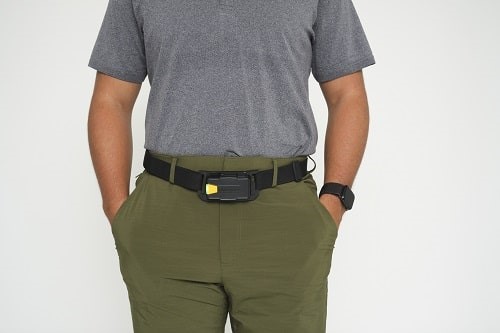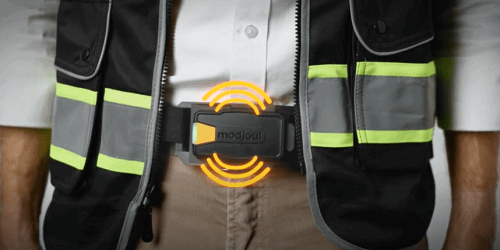Artificial intelligence and wearable technology can now be used to assess and provide feedback on the ergonomic risks posed by high impact and repetitive tasks, making it quicker and easier to identify ways of improving training and work processes to reduce the risk of musculoskeletal injuries.
Features
How wearable tech helps reduce MSD and collision risks
Artificial intelligence (AI) and wearable technology devices have been transforming health and safety policy and practices in the US for some time and are now starting to make inroads into the UK.
This technology has the potential to reshape how businesses train staff and develop health and safety policies in their organisations and key to that transformation is the detailed real-time data that these wearable devices can learn and collect about the workplace environment.
This AI technology has the ability to track individual task movements around specific job roles and monitor how risky movements can be mitigated over time using a combination of targeted training and smart technology.
 The real-time data that wearable devices can learn and collect about the workplace environment can be transformative for managing MSDs. Photograph: Stanley
The real-time data that wearable devices can learn and collect about the workplace environment can be transformative for managing MSDs. Photograph: Stanley
All this matters because workplace accidents and injuries, such as musculoskeletal disorders (MSDs), are one of the biggest causes of dips in productivity and one of the main reasons that workers take time off sick in the UK.
According to the latest figures from the Health and Safety Executive, the total number of cases of work-related MSDs in 2022/23 in the UK was 473,000 and a 2023 survey conducted by the CIPD and Simplyhealth found that 51 per cent of long-term sickness absence in the UK is caused by musculoskeletal injuries. Wearable technologies can help businesses reduce these numbers dramatically by collecting and tracking detailed employee data, to focus on where the biggest risks to workplace safety lie.
In the UK, AI solutions such as the WearHealth exoskeleton scanning technology and the Modjoul SmartBelt are just starting to come onto the market, bringing disruptive change. These AI data-driven solutions allow for a more advanced level of protection for workers who are at greater risk of workplace injury, particularly in sectors like construction, warehouse picking and packing and manufacturing. The wearable technology is a quick and easy way for employers to collect detailed data that can help them to track workplace activity and provide a more holistic view of the effectiveness of their health and safety polices.
How does it work?
There are a number of wearable technology solutions on the market. For example, technology providers like WearHealth specialise in matching the right exoskeleton suit to the physical task being performed, with the aim of ensuring that the suit can assist in the usual daily tasks without the wearer being exposed to musculoskeletal injury as a result.
 The Modjoul SmartBelt device emits haptic feedback when a risky movement is performed to start to influence the behaviour of the worker. Photograph: Stanley
The Modjoul SmartBelt device emits haptic feedback when a risky movement is performed to start to influence the behaviour of the worker. Photograph: Stanley
Video scanning technology is used to assess a particular task using an app. The worker is videoed performing the activity and the data is then processed by an algorithm to assess the MSD risk. An ergonomist then reviews the data to take into consideration the weight carried, static movements, scheduled breaks etc. From this data, a detailed report is written which recommends the most suitable exoskeleton that can be worn to reduce the MSD risk for the specific tasks.
Once a suit is selected from the recommendations, the organisation can trial its effectiveness using sensor analysis on the worker’s neck, leg and heart. The activity is carried out without the suit to provide a benchmark and then the sensors are worn by the worker while wearing the suit to demonstrate the improvement comparison metrics. Organisations can then clearly see the impact of the exoskeleton before and after, creating a business case for future investment.
For jobs that require a lot of physical lifting and stretching in environments like warehousing and construction, it is mostly new, onboarded staff that are at most at risk of injury. In fact, wearable technology statistics show us that within the first two months of employment, there is a 70 per cent increased risk of injury and that one in eight of all workplace injuries happen on an employee’s first few weeks on the job.
Targeted use of wearable technology like the Modjoul SmartBelt device – which emits haptic feedback when a risky movement is performed – will start to change the behaviour of the worker.
The Modjoul SmartBelt generates feedback to management in real time, delivering analytic reports showing which activities are contributing to the potential occurrence of injuries. This data allows managers to proactively intervene to minimise risks if dangerous patterns of movement are regularly occurring. Predictive analytics can also help optimise work schedules, make sure that the workload is distributed evenly and moderate task assignments for particular workers to reduce the likelihood of MSD injuries.
Anti-collision technology
Another benefit of wearable technology is the ability to keep the workplace environment safe. For example, when people and machines operate together in close proximity, the potential for workplace accidents inevitably rises. In the UK, between 2016–2019, 43 per cent of forklift truck incidents involved impact with a person and 65 per cent of these involved pedestrians unconnected with the activities of the forklift. These figures from the UK Materials Handling Association clearly show that danger is heightened when people work in an environment that contains mechanical vehicles, such as forklift trucks, excavators and cranes.
 Graham Sharp: "(AI) and wearable technology devices have been transforming health and safety policy and practices in the US for some time and are now starting to make inroads into the UK."
Graham Sharp: "(AI) and wearable technology devices have been transforming health and safety policy and practices in the US for some time and are now starting to make inroads into the UK."
AI wearable technology is tackling this issue head-on to help prevent workplace accidents. For example, Modjoul’s wearable SmartBelt communicates with forklift or plant operators and other workers in the vicinity, while simultaneously measuring ergonomics and environmental factors. Combined with ultra-wide band (UWB) and beacon technology, units are installed inside the industrial vehicle to provide an accurate location of the moving plant in real-time within centimetres. Units are also positioned throughout the warehouse or construction site to provide real-time alerts in high-risk areas such as blind spots or when a crane is operating overhead.
Workers on the floor receive haptic proximity alerts from their SmartBelt wearable device alerting them to the presence of a forklift or other industrial vehicle. Simultaneously, drivers are alerted to a worker’s presence via a tablet-like display in their cab. The devices simultaneously collect data and measure ergonomic and positioning factors, ensuring that there is detailed data into potential near misses in specific zones.
Results-driven planning
Once the data analysis has identified potential issues which might include MSD injury or the risk of a forklift collision, organisations can adopt a more proactive approach to risk management using a combination of enhanced training and use of wearable technology to help bring about gradual behaviour change across an organisation. Effective risk control measures may include:
- More comprehensive training on lifting, bending and carrying materials (manual handling) – looking at specific groups based on risk factors such as age, new starters, riskiest activities etc.
- Involving staff in setting targets and making health and safety improvements – for example, reward-based systems. In the US, businesses using this type of technology have found that if workers themselves are able to track their own progress either on their own mobile phones, via a bespoke app or on supplied in-house technology, they are more invested in their own health and wellbeing. So, for example, workers can track their performance and see whether they are reducing their hazardous movements. This can be potentially linked to an incentive-based system where individuals may get a reward when they hit specific safe behaviour targets.
- Tracking progress post-training to ensure that employees stay on track and act on the training they have had on risk avoidance. Where weaknesses are identified, wearable technology can be used to help reinforce correct movement and avoid potential injury.
By using data analysis in this way, a more accurate and targeted training regime can be implemented. Studies from the US have shown that accident figures substantially decrease once the technology has identified which riskier tasks need to be targeted with further training and continued monitoring using the wearable technology.
Return on investment
There is no denying that wearable technology is an added investment for a business, but the US model has shown that this initial outlay is soon recouped as sickness and injury levels drop, injury claims are far less frequent, and health and safety budgets are spent more wisely.
As deployment in the US is already demonstrating, this technology can also improve productivity and efficiency for certain tasks while improving health and wellbeing. We would not be aware of that without access to real-time data. Businesses can now have access to solid information that can be used to underpin health and safety decision-making and transform staff health and wellbeing.
Stanley helps businesses to reduce manual handling injuries, improve efficiency, and cut costs by utilising the latest technologies in AI, wearable safety tech and powered stair solutions.
For more information see: stanleyhandling.co.uk
Graham Sharp is managing director at Stanley
FEATURES

Sedentary working and how to combat the ‘sitting disease’
By Gavin Bradley, Active Working on 05 April 2024
Prolonged and excessive sitting poses a major risk to our health, but the Get Britain Standing campaign and On Your Feet Britain Day on 25 April are a great way of encouraging workers to sit less and move more.

Company culture and wellbeing: a crucial link
By Bex Moorhouse, Invigorate Spaces on 05 April 2024
Investing in measures to support worker wellbeing will be ineffective unless the company culture genuinely incorporates values like teamwork, involvement, flexibility and innovation.

Office design and culture: happier and healthier staff – or the opposite?
By Guy Osmond, Osmond Ergonomics on 03 April 2024
Applying ergonomic principles to workstation set-ups and ensuring the physical environment supports neurodivergent people are just some of the ways of creating an office where everyone can thrive, but a supportive and positive organisational culture is vital too.


